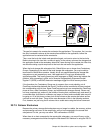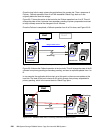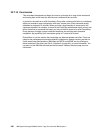
Chapter 23. Global Mirror options and configuration 291
//SYSTSIN DD DDNAME=SYSIN
FCESTABL SDEVN(X'3C00') TDEVN(X'3E00') MODE(ASYNC)
Now you may restart the applications at the remote site using the B volumes. Note the B
volumes are Global Copy primary volumes in suspended state, which implies that change
recording takes place. Later this allows you to resynchronize from B to A, before returning to
the local site.
Eventually, here you may also decide to create another copy of this consistent set of
volumes, and create D volumes, or preserve this set of consistent volumes on tape. When
you create the D volumes, this is just a plain FlashCopy command. Example 23-11 shows an
example with the B volume as FlashCopy source and a new D volume as FlashCopy target.
Example 23-11 Create another set of consistent data volumes
//* ---------------------------- TSO ------------ CREATE (5) ----- ***
//* FLASHCOPY B -> D TO CREATE COPY TO WORK (TEST) WITH ***
//* -------------------------------------------------------------- ***
//FCESTBL EXEC PGM=IKJEFT01
//SYSPRINT DD SYSOUT=*
//SYSTSPRT DD SYSOUT=*
//SYSTSIN DD DDNAME=SYSIN
FCESTABL SDEVN(X'3C00') TDEVN(X'3E02')
Note that this is a full volume FlashCopy. This is because at a previous step we reestablished
the FlashCopy relationship between B and C, indicating it was part of a Global Mirror
environment. This indication carries the
start change recording attribute, which implies that
you can only use the same source volume for full volume FlashCopy—only a single
incremental relationship is allowed per source volume.
In a disaster situation you might use the MODE(COPY) for the FlashCopy from B to C, to
remove the FlashCopy I/O overhead of MODE(ASYNC), which implies
start change
recording
or incremental FlashCopy.


















